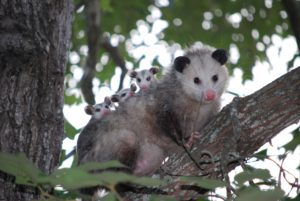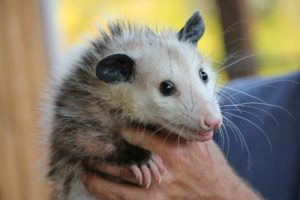Opossums, commonly known as possums, are a mammal you don’t want to get too close to. They can carry a myriad of diseases and host other pests such as fleas and ticks. They can also cause considerable damage to your home. They can weasel their way in by chewing and clawing through siding or shingles. Once inside, they can wreak havoc by chewing through electrical wiring and wood or by scratching your insulation to pieces.

What is a Opossum’s Biology?
Opossums are one of three marsupial species native to North America and can be found in over two-thirds of the country. These nocturnal animals are fairly solitary, only coming together to mate. The average female opossum will an average of 15-25 babies per year. However, the mother opossum keeps the babies in her pouch where they can stay warm and drink milk to get bigger and stronger. The babies become completely weaned by 100 days after their birth.
These marsupials are known for their distinct bald, prehensile tail that averages 1.5 feet long. “Prehensile” means they can use it to grab onto things. Possums mainly use their hairless tails to grab onto tree branches to help them climb through the trees. Rarely do they hang upside down because they’re so heavy. Sometimes their young will do so, but the adults are just too large, weighing in at an average of 15 pounds.
To help them keep up with their sturdy weight, possums eat lots of different things. They are omnivores meaning they eat meat and plant matter. This scavenger’s most preferred meal is carrion (decaying flesh), but they also like to eat insects, acorns, and pet food. They’re not shy when it comes to the garbage can, either.
How do opossums defend against predators?
An opossum has two main forms of defense when it comes to would-be predators. The first defense involves lots of hissing with their mouths wide open to display their 50 sharp teeth! If this fails to work, they move to a second defense. By falling to the side, staying completely still and lulling their tongue to the side, these animals give a very convincing impersonation of a dead critter. They do this to deter some predators that would prefer a live meal.
How to prevent possums?

Preventing your home from a possum invasion is possible, but sometimes, these resourceful animals will find their way in anyways. Here are some tips to keep these critters out.
- Clear your yard of any clutter that could hide an animal like a possum. Not only will this help prevent possums, but also cockroaches and other pests.
- Possums will hunker down under low lying porches or in crawlspaces. Sealing these places with rocks, branches or other means will discourage them from nesting.
- Seal any holes and note any damage on the exterior of your home. Signs of a possum invasion are numerous and include damaged siding and shingles.
- Put your pet on a feeding schedule. This will enable you to pick up the pet food dishes so other unwanted guests won’t feed on the leftover food.
- Place your garbage in a sealed container that isn’t accessible to rodents and the like.
If you have unwanted opossums in your home or yard, call us! We will effectively remove them from your home while taking steps to prevent another nesting of possums.
